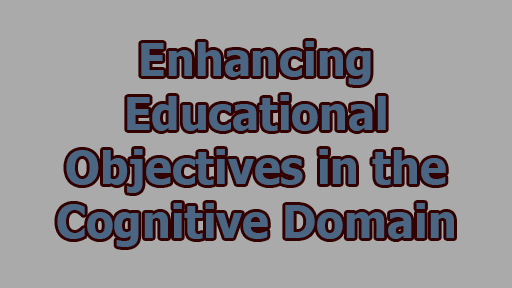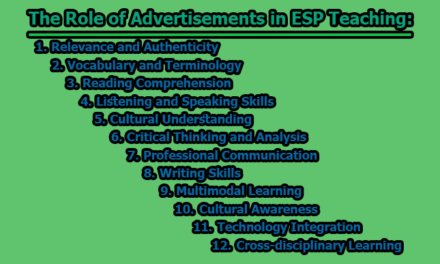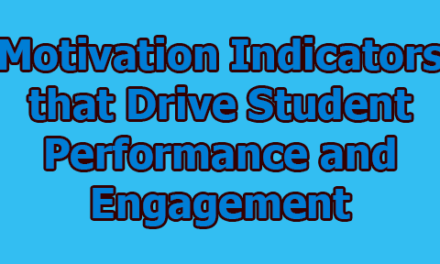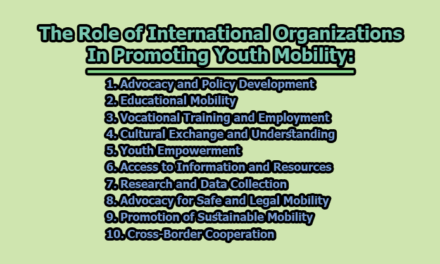Enhancing Educational Objectives in the Cognitive Domain:
The cognitive domain of Bloom’s taxonomy encompasses a spectrum of educational objectives, from basic recall of knowledge to higher-order thinking skills such as critical analysis and creative problem-solving. This taxonomy serves as a foundational framework for educators and curriculum developers to design learning experiences that foster students’ intellectual growth. The six levels of cognitive objectives, namely Remembering, Understanding, Applying, Analyzing, Evaluating, and Creating, provide a structured approach to promote deep learning and meaningful engagement in the classroom. In recent years, there has been a growing emphasis on improving the classifications of educational objectives within the cognitive domain. Educators and researchers recognize the significance of refining these classifications to cater to the evolving needs of students, society, and the workforce. This article aims to explore various strategies and approaches for enhancing educational objectives in the cognitive domain, ensuring they align with contemporary educational theories and methodologies. By doing so, educators can facilitate more effective teaching and learning experiences that foster critical thinking, problem-solving, and creativity among students.
Section 1: Remembering: Remembering is the foundational level of cognitive objectives, involving the ability to retrieve, recognize, and recall relevant knowledge from long-term memory. It forms the basis for higher-order thinking skills and is essential for building a strong understanding of any subject. To improve the classification of objectives at this level, educators can employ various strategies and techniques:
- Spaced Repetition: Spaced repetition is a method that involves reviewing information at increasing intervals over time. By spacing out the practice of recalling information, students reinforce their memory and enhance long-term retention. Educators can implement spaced repetition through regular quizzes, flashcards, and online learning platforms.
- Interactive Learning Methods: Engaging students in interactive learning experiences can stimulate their memory recall. Utilizing educational games, simulations, and role-playing activities encourages students to actively participate in the learning process, making it more enjoyable and memorable.
- Technology-Driven Interventions: Embracing educational technology can enhance remembering objectives. Virtual reality, augmented reality, and multimedia presentations can help create vivid and immersive learning experiences, aiding students in recalling information more effectively.
- Formative Assessments and Personalized Feedback: Formative assessments, such as low-stakes quizzes and informal discussions, enable educators to gauge students’ understanding and memory retention regularly. Providing personalized feedback based on these assessments helps students identify areas for improvement and reinforces their memory of key concepts.
Section 2: Understanding: Understanding involves constructing meaning from oral, written, and graphic messages through interpreting, exemplifying, classifying, summarizing, inferring, comparing, and explaining. To improve the classification of objectives at this level, educators can employ the following strategies:
- Active Learning Strategies: Active learning encourages students to participate actively in the learning process. Utilizing techniques such as group discussions, think-pair-share exercises, and debates can promote a deeper understanding of complex concepts and foster critical thinking skills.
- Concept Mapping: Concept mapping is a visual representation of the relationships between different ideas and concepts. By creating concept maps, students can organize information in a hierarchical and interconnected manner, facilitating a more coherent understanding of the subject matter.
- Collaborative Group Activities: Collaborative learning fosters teamwork and communication skills while promoting a deeper understanding of topics. Group projects, problem-solving tasks, and peer teaching activities allow students to share their perspectives and collectively build a comprehensive understanding of the material.
- Real-World Applications: Relating classroom concepts to real-world scenarios helps students see the practical relevance of their learning. Case studies, field trips, and guest speakers can bridge the gap between theory and practice, enhancing students’ comprehension and motivation.
Section 3: Applying: Applying involves carrying out or using a procedure through execution or implementation. To refine the classification of objectives related to application, educators can use the following strategies:
- Real-World Problem-Solving Scenarios: Presenting students with authentic, real-world problems challenges them to apply their knowledge and skills in practical situations. These scenarios encourage critical thinking, creativity, and adaptability, preparing students for challenges beyond the classroom.
- Case Studies and Simulations: Case studies and simulations offer a controlled environment for students to practice applying their knowledge to specific contexts. These immersive experiences allow students to explore various solutions and understand the consequences of their decisions.
- Project-Based Learning: Project-based learning (PBL) engages students in hands-on projects that require them to apply multiple skills and concepts to achieve a tangible outcome. PBL encourages collaboration, time management, and problem-solving abilities, leading to a deeper understanding of the subject matter.
- Service-Learning Opportunities: Service-learning integrates community service with academic learning, providing students with opportunities to apply their knowledge to address real community needs. Engaging in service-learning projects not only enhances students’ application skills but also fosters empathy and social responsibility.
Section 4: Analyzing: The fourth level of cognitive objectives, Analyzing, revolves around breaking down material into constituent parts and understanding how these parts relate to an overall structure or purpose. To improve the classification of objectives in analysis, educators can use the following strategies:
- Critical Thinking Exercises: Introducing critical thinking exercises challenges students to evaluate information, identify patterns, and draw logical conclusions. Socratic questioning, thought experiments, and debates can enhance students’ analytical skills and promote a deeper understanding of complex topics.
- Data Analysis Projects: Incorporating data analysis tasks allow students to work with real data and draw meaningful insights from it. Analyzing data sets, conducting surveys, and interpreting research findings develop students’ ability to extract essential information from various sources.
- Comparing and Contrasting: Encourage students to compare and contrast different concepts, theories, or historical events. This helps them discern similarities, differences, and underlying patterns, fostering a deeper understanding of the subject matter.
- Attribute Analysis: Attribute analysis involves identifying and examining the characteristics, components, or elements of a particular subject. Students can conduct attribute analyses in literature, art, scientific experiments, and historical events, providing them with a comprehensive understanding of the subject’s structure.
Section 5: Evaluating: Evaluating entails making judgments based on criteria and standards through checking and critiquing. To enhance the classification of objectives related to evaluation, educators can use the following strategies:
- Debates and Discussions: Organizing debates and discussions on controversial topics allow students to critically evaluate different perspectives and develop well-reasoned arguments. Encouraging constructive criticism and respectful discourse nurtures their evaluative abilities.
- Peer Assessments: Implementing peer assessments empowers students to assess each other’s work based on specific criteria. This process encourages self-reflection and helps students develop a more discerning eye for evaluating their own and others’ performance.
- Ethical Discussions: Engaging students in ethical discussions encourages them to consider moral and ethical implications when making judgments. Exploring ethical dilemmas cultivates a sense of responsibility and empathy, promoting more thoughtful and balanced evaluations.
- Rubrics and Assessment Criteria: Clear rubrics and assessment criteria provide students with a transparent framework for evaluation. By understanding the expectations and standards, students can make more informed and accurate judgments about their work.
Section 6: Creating: The final level of cognitive objectives, Creating, involves putting elements together to form a coherent or functional whole. To refine the classification of objectives in this domain, educators can use the following strategies:
- Project-Based Assessments: Assigning open-ended, creative projects allows students to demonstrate their ability to synthesize knowledge and skills. Projects may include designing a product, creating a piece of art, writing a story, or developing a business plan, fostering innovation and originality.
- Design Thinking Challenges: Design thinking is a problem-solving approach that emphasizes empathy, ideation, prototyping, and testing. Introducing design thinking challenges encourages students to think creatively, solve complex problems, and iterate their solutions.
- Artistic Expressions: Incorporating arts into the curriculum provides students with a platform to express their creativity. Artistic activities, such as music, drama, and visual arts, encourage students to think outside the box and explore unconventional approaches.
- Entrepreneurial Ventures: Encouraging students to develop entrepreneurial ventures allows them to apply their knowledge and skills to real-world contexts. Creating a business plan, designing a social initiative, or launching a product fosters innovation and an entrepreneurial mindset.
In conclusion, enhancing the classifications of educational objectives in the cognitive domain is paramount for creating impactful and relevant learning experiences. By incorporating strategies such as spaced repetition, active learning, real-world applications, critical thinking exercises, and creative projects, educators can foster a dynamic and engaging learning environment. Each level of cognitive objectives, from Remembering to Creating, plays a crucial role in developing students’ intellectual abilities and preparing them for future challenges. By refining these classifications, educators empower students to become lifelong learners, critical thinkers, and innovative problem solvers, ensuring they are well-equipped to thrive in an ever-evolving world.
Reference:
Barak, M. (2013). Teaching engineering and technology: Cognitive, knowledge and problem-solving taxonomies. Journal of Engineering, Design, and Technology, 11(3), 316–333. https://doi.org/10.1108/JEDT-04-2012-0020

Former Student at Rajshahi University










